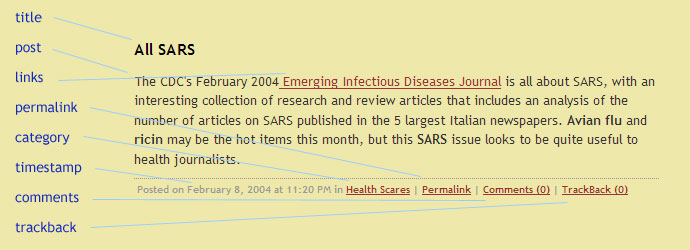blogs - anatomy
Blogs share a common format. This uniformity facilitates usability by allowing readers to quickly skim a blog for interesting information. “The weblog format provides a framework for our universal blog experiences, enabling social interactions we associate with blogging,” writes Blogger co-founder Meg Hourihan.
The features of a blog include:
- Date header: The date the post is written. Posts are generally presented in reverse chronological order (most recent first).
- Title: Each post is given a title. This is a pithy phrase, a pun, or even a series of symbols.
- Time stamp and/or permalink: The time the post is uploaded to the blog. The time stamp often is a link to a permanent page just for this post. This allows other bloggers to link to a post.
- Post: A word, sentence, paragraph or essay, with links and names and current news. Key words and names are often highlighted in boldface, which makes the post 'scannable' (the usability gurus at Useit.com tell us that online readers don't read - they scan a page).
- Author nickname: The name or nickname of the person who wrote the post. For blogs written by one person, the author is often left off (because the author identification can be found in an About page). For collaborative blogs, the author helps to differentiate contributors. The nickname can also be a link to a page of all the author’s posts.
- Category: Individual postings are often labeled as part of a category.
- Comments: A software feature that allows readers to leave their own comments and reactions to the author’s post.
- TrackBack: A way for one blog post to link to the post of another blog. In other words, one blogger can write about the content of another person's weblog, and the two posts are linked in a web. See the Beginner's Guide to TrackBack.

next page: reading & writing blogs >>
blogging101 home | Tar Heel Bloggers home | JOMC 50 home
by Anton Zuiker, last updated 02.27.2004


